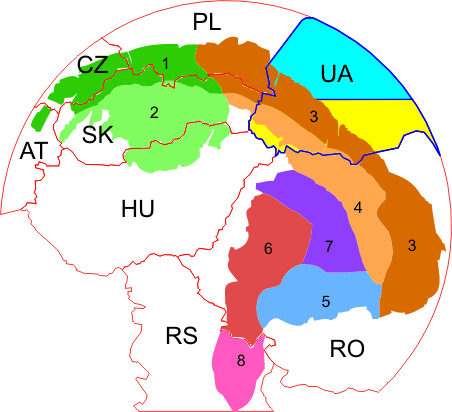Ecology and natural resources
The preservation and permanent drawing on Carpathian natural resources demands the collaboration of all the Carpathian regions. Thus within the framework of Carpathian convention (2003) the range of agreements was celled about the collaboration of people of Carpathians in the different spheres of life and first of all in the field of natural environmental defense.

1. Outer Western Carpathians 2. Inner Western Carpathians
3. Outer Eastern Carpathians 4. Inner Eastern Carpathians
5. Southern Carpathians 6. Western Romanian Carpathians
7. Transylvanian Plateau 8. Serbian Carpathians
According to the Convention Carpathian region is one of the most important ecological, economic and social regions of Europe. It is the region with high concentration of biodiversity and the great part of the European forest ecosystems functional base is concentrated on its territory ensuring thus the territorial ecobalance to the great extent.
In Europe this part is assigned to mountain regions. The ecological, cultural and socioeconomic value of the mountain regions was given the priority in “21st century Order Paper” Action Programme (Rio de Janeiro, 1992, Chapter 13: Mountain regions steady development) and also in the Declaration on the Human Environment and Carpathian, Danube Regions Steady Development (Bucharest, 2001). This indicates the importance of finding the ways of mountain regions nature conservation.
In this connection the UN General Assembly proclaimed the year of 2002 to be the mountain year. The Ukrainian Carpathians make the central part of Carpathian range which unites its largest southern and western parts. Thus the Carpathian natural ecosystems protection on the territory of Ukraine is especially important concerning the green corridor preservation of the parts in particular and of the Carpathian macroecosystem on the whole.
The territory of Transcarpathia covers the main part of East Carpathians southern hillsides and is the head of Tysa river international water flow basin.
The great natural ecosystems biodiversity preservation for one part and the investment appeal of the region due to the valuable recreational and other resources availability for the other part together with the geopolitical location of the region require the nature protection regional model development since the embodiment of modern nature protection conceptions didn’t prevent from the biotypes destruction, loss of fauna and flora species and of functional centre of Tysa river basin natural ecosystems.
The main timber resources, the largest area unit of water resources and the most precious (balneological) and the richest (in the number of territorial mineral springs) recreational resources are concentrated on the territory of Transcarpathia which occupies the head of Tysa river basin. At the same time the region is a relatively closed ecosystem of Tysa riverhead (the largest effluent of the Danube, Europe’s main water course) and this causes high interference degree of all types of vegetation and its light reaction to the changes in hydrological regime.
Comment